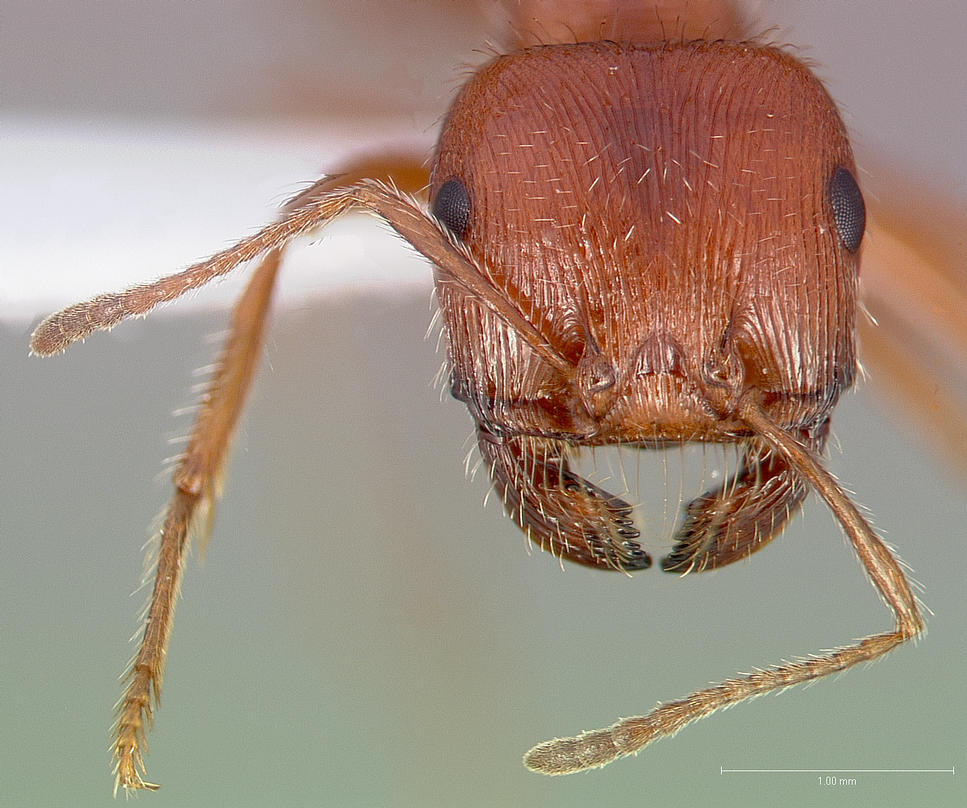Form and Function
The California harvester ant is among the most common and easily
observed ants in the southwestern United States and is well adapted to
desert life (CAS 2004). It is small and reddish-brown, and it has hairs all over its body, especially under its head. The hairs under its head make up what
is known as the psammophore, which is beard-like in appearance and
is used to carry loose sand (Pogolumina 2010).
 It
also has very powerful mandibles, which are a pair of
appendages near its mouth used for both
harvesting seeds and protecting itself (Navajo Nature 2010). Without the adaptation of
the mandibles, the primary source of food for the ant society,
seeds, would be quite difficult to obtain (Navajo Nature 2010). Pogonomyrmex
californicus is also well-known for its
powerful sting that is administered
by the stinger that protrudes from the tip of the gaster, or the
terminal body part, to help ward off predators, as well as the
potent venom that accompanies the sting (Pogolumina 2010).
Yet another key adaption that the organism has developed is
its high tolerance to heat. Studies show that this ant can
tolerate a maximum temperature of 51 degrees Celsius, or
approximately 124 degrees Fahrenheit (Quinlan and Lighton 1999).
Pogonomyrmex californicus has a relatively small body size compared
to most other species within the genus Pogonomyrmex, and that
physiological adaption seems to be highly correlated to its high
heat tolerance, as being small helps workers shed heat
faster when heat-stressed (Navajo Nature 2010). These high temperature tolerances give an extra edge to the survival of Pogonomyrmex
californicus over other ants because it lives in
dry and arid
desert habitats where the average foraging day can be well over
50 degrees Celsius (Navajo Nature 2010).
It
also has very powerful mandibles, which are a pair of
appendages near its mouth used for both
harvesting seeds and protecting itself (Navajo Nature 2010). Without the adaptation of
the mandibles, the primary source of food for the ant society,
seeds, would be quite difficult to obtain (Navajo Nature 2010). Pogonomyrmex
californicus is also well-known for its
powerful sting that is administered
by the stinger that protrudes from the tip of the gaster, or the
terminal body part, to help ward off predators, as well as the
potent venom that accompanies the sting (Pogolumina 2010).
Yet another key adaption that the organism has developed is
its high tolerance to heat. Studies show that this ant can
tolerate a maximum temperature of 51 degrees Celsius, or
approximately 124 degrees Fahrenheit (Quinlan and Lighton 1999).
Pogonomyrmex californicus has a relatively small body size compared
to most other species within the genus Pogonomyrmex, and that
physiological adaption seems to be highly correlated to its high
heat tolerance, as being small helps workers shed heat
faster when heat-stressed (Navajo Nature 2010). These high temperature tolerances give an extra edge to the survival of Pogonomyrmex
californicus over other ants because it lives in
dry and arid
desert habitats where the average foraging day can be well over
50 degrees Celsius (Navajo Nature 2010).
P. californicus, using its many adaptations, reacts well to
environmental stimuli. To explain, colony size is a fundamental attribute of insect societies that
appears to play an important role in the organization of work
(Holbrook et
al. 2013). According to the same article, in the California
harvester ant, the division of labor of certain tasks increases with
colony size. Larger colonies perform
more waste management and food processing per individual than do
smaller colonies (Holbrook et
al. 2013).
Of course, Pogonomyrmex californicus would not be able to
perform tasks without the use of its legs, which serve as its
primary method of movement. These legs are yellowish in color,
similar to the color of the mandibles (Wheeler 1914). The legs are
designed for running, as they are powered by muscles in the
mesosoma, the second body segment of the organism (ASU 2010). At the
end of each of the six legs is a hooked claw that aids in climbing
and hanging onto objects (ASU 2010).
Go back to the Habitat page Go to the Home page Go on to the Reproduction page